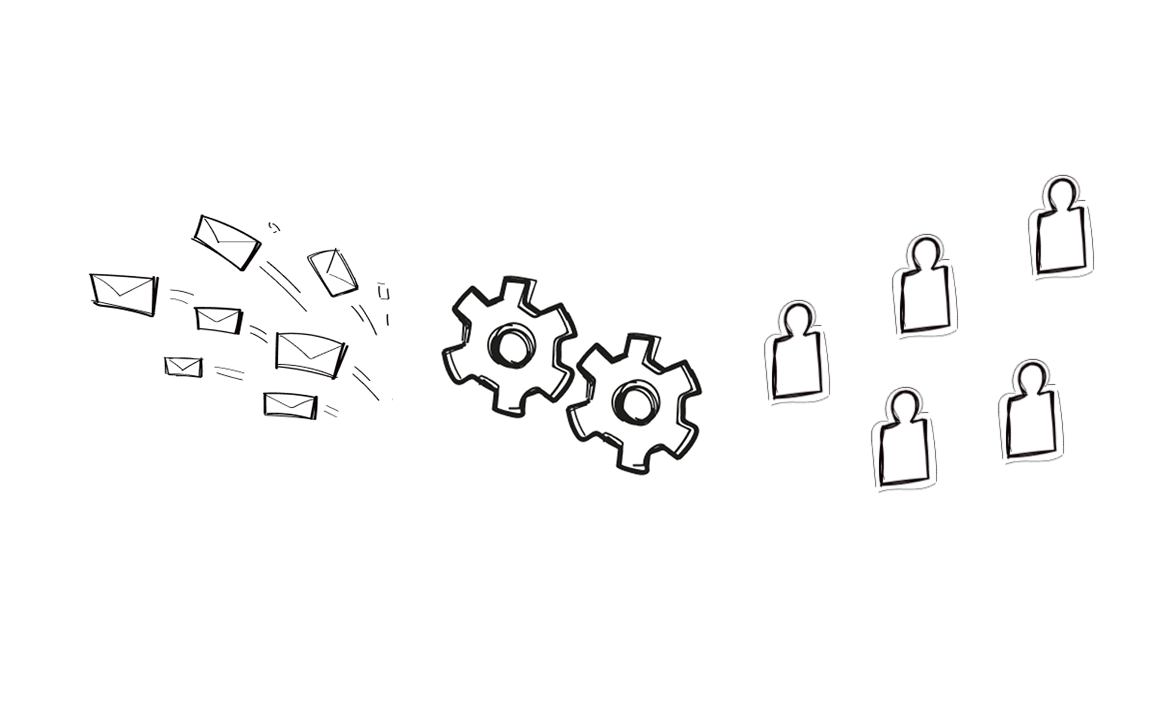Personalizing your outreach doesn’t mean you have to write every email by hand. In today’s digital age, reaching out to hundreds or thousands of prospects is a must—but it’s possible to do so without sounding robotic. This guide will show you how to balance automation with a personal touch so that your outreach feels like a genuine conversation rather than a mass-produced message.
Understanding the Challenge
When you send a generic, automated message to a large group of people, chances are, your message will feel impersonal and cold. Recipients might ignore it or, worse, mark it as spam. The key to successful outreach is to create messages that feel tailored to each recipient—even when you’re sending them in bulk.
Imagine you’re at a party, and someone greets everyone with the same one-liner. It wouldn’t feel special, would it? You’d rather appreciate someone taking a moment to ask how you’re doing or commenting on something unique about you. The same principle applies to outreach.
Key Statistics: Why Personalization Matters
Data-driven insights show just how important personalized outreach is for engagement and conversion rates. Here are six key statistics that highlight its significance:
- Emails with personalized subject lines are 26% more likely to be opened. (Campaign Monitor)
- This emphasizes the power of using the recipient’s name or company in subject lines to grab attention.
- Marketers see a 760% increase in revenue from segmented campaigns. (Campaign Monitor)
- Segmentation leads to more relevant messaging, making audiences more likely to engage and convert.
- Consumers are 80% more likely to purchase from brands that offer personalized experiences. (Epsilon)
- People appreciate content tailored to their needs, which increases trust and willingness to buy.
- Open rates for emails with personalized content are 29% higher than non-personalized emails. (Statista)
- Adding details relevant to the recipient significantly improves engagement.
- 78% of consumers say personally relevant content increases their purchase intent. (Instapage)
- Beyond just engagement, personalization directly impacts buying decisions.
- Businesses that use advanced personalization see an average of 20% higher sales. (McKinsey)
- Investing in personalization at scale can drive significant revenue growth.
These numbers prove that personalization isn’t just a nice-to-have—it’s essential for improving outreach effectiveness and boosting engagement.
Two Key Strategies for Personalized Outreach
Here are two simple strategies to help you maintain a personal touch while reaching out at scale:
Humanize Your Templates:
- Write your emails in a friendly, conversational tone. Use everyday language and avoid overly formal phrasing.
- Include personalization tokens that automatically insert the recipient’s name or company, but also add a short sentence that relates specifically to their interests or recent activities.
Segment Your Audience:
- Group your contacts based on common traits such as industry, interests, or previous interactions. For example, escape room businesses can segment their audience by corporate team-building groups, birthday party inquiries, or returning players, allowing for more relevant outreach. This lets you create different templates that resonate with each group.
- Tailor your messaging for each segment. A message that speaks directly to a specific challenge or opportunity feels more relevant and genuine.
By humanizing your templates and segmenting your audience, you can make each email feel like a custom-tailored message, even if you’re sending hundreds of them.
Cold Email Outreach in Recruitment
When it comes to cold email outreach recruitment, personalization is just as crucial for building relationships and attracting top talent. A tailored email stands out in a crowded inbox, especially in the recruitment world, where candidates receive countless generic job offers. Here’s how personalization can elevate your cold email recruitment outreach:
- Tailored Job Descriptions: Personalize the role description by matching the job’s responsibilities with the candidate’s specific skills or past experience.
- Direct Relevance: Mention why you specifically chose to reach out to them. Highlight how their expertise aligns with the job opening.
- Personal Connection: Reference mutual connections or shared interests to build rapport and make the outreach feel more genuine.
- Value Proposition: Focus on the benefits that will resonate most with the individual. For instance, mention opportunities for growth or flexibility, rather than generic company perks.
These small tweaks can turn a cold email into a meaningful interaction, leading to higher response rates and attracting the right candidates.
Crafting the Right Message
Creating the perfect outreach email starts with a clear purpose. Know what you want to achieve—whether it’s setting up a meeting, sharing valuable content, or simply starting a conversation—and let that purpose guide your writing. Here are some tips to keep your message engaging:
- Start with a Warm Greeting: Open with a friendly, personalized greeting. Instead of “Dear Customer,” try “Hi [Name],” or “Hello [Name],” followed by a line that references something specific to them.
- Be Clear and Concise: Get to the point quickly. Explain why you’re reaching out and what value you’re offering in a few short sentences.
- Show Genuine Interest: Reference a recent achievement or a common interest. For example, “I noticed your company recently launched a new product, and I’d love to learn more about your experience.”
- Include a Call-to-Action: End with a simple, clear call-to-action. Invite them to reply, schedule a call, or check out a link for more information.
When every message is crafted with these elements, your outreach becomes a series of genuine conversations, rather than cold blasts.
Using Tools to Enhance Personalization
Automation tools like Apollo can help you maintain a personal touch without spending hours on each email. Many modern CRM systems, outreach platforms or even AI for content personalization allow you to use templates with smart personalization features. Here’s how to make the most of these tools:
- Dynamic Fields: Use dynamic fields to automatically insert details like the recipient’s name, company, or recent activity. This small touch can make a big difference in how your message is received.
- Scheduled Sending: Automate your outreach so that emails are sent at the right time. Tools can help you analyze when your recipients are most likely to engage.
- A/B Testing: Experiment with different subject lines, greetings, and calls-to-action to see which versions lead to higher responses. Use this data to refine your templates over time.
By leveraging these features, you can keep your outreach scalable and efficient without sacrificing the warmth and personalization that makes your emails stand out. You can improve personalization even further by integrating studio management software, which streamlines client communication and automates tailored responses efficiently.
Building a Connection at Scale
Personalization at scale is about creating a connection—even if you’re sending many emails. Think of each email as the first step in a long-term relationship. Even if the initial reply is small, a well-crafted email can pave the way for more meaningful interactions down the road.
Here’s what to keep in mind:
- Consistency is Key: Maintain a consistent voice and style across all your emails. This helps reinforce your brand and builds trust over time.
- Follow-Up Thoughtfully: A well-timed follow-up can show that you’re genuinely interested in a conversation, not just pushing a product. Keep follow-ups short, friendly, and always provide an easy way to opt out.
- Listen and Adapt: Monitor your response rates and feedback. Use this information to adjust your templates and improve your outreach strategy continuously.
- Offer value: Offer value through free resources and discounts. For example, in an outreach email inviting customers to join your referral program, you can include a referral incentive. Referral program tools, such as ReferralCandy, let you automatically set up these referral rewards.
When your outreach feels like a natural conversation rather than a sales pitch, recipients are more likely to engage and respond.
Ethical Considerations in Personalized Outreach at Scale
When personalizing outreach at scale, it’s essential to pause and consider the ethical implications of using data-driven techniques to tailor messages. While personalization can significantly enhance engagement and build meaningful connections, it also raises several moral dilemmas that deserve careful thought. Below, we examine five key ethical issues and explore the arguments for and against each, encouraging you to think critically about the moral dimensions of your outreach strategy.
1. Data Privacy and Consent
Personalized outreach relies on collecting and analyzing personal data, which naturally raises concerns about privacy. On one hand, proponents argue that when users willingly share their information—often in exchange for valuable content or services—they implicitly consent to its use in personalizing communications. This can lead to a more relevant and engaging experience. On the other hand, critics contend that even with consent, users might not fully understand how their data is used or the extent to which it is tracked, leading to potential misuse or data breaches. It is essential to maintain transparent data practices and robust security measures while ensuring that users can easily opt out if they choose.
2. Transparency and Authenticity
The effectiveness of personalized outreach depends on presenting messages that feel genuine and tailored. Advocates believe that transparency—such as clearly stating why and how personalization is applied—builds trust between the sender and the recipient, leading to deeper relationships. Conversely, there is a risk that too much personalization might come across as manipulative if users feel they are being profiled or if they suspect hidden motives. Balancing transparency with authenticity means openly communicating the benefits of personalized messaging without overstepping boundaries, ensuring that recipients feel respected rather than exploited.
3. Bias in Personalization Algorithms
Personalization tools are only as good as the data they are trained on, which can sometimes lead to biased outcomes. On one side, these algorithms can help tailor content to diverse audiences, enhancing relevance and inclusivity. However, if the underlying data contains biases, the personalized messages might inadvertently reinforce stereotypes or exclude certain groups. It is important to continuously audit and refine these systems, ensuring that the personalization process is fair and does not marginalize any segment of your audience.
4. Over-Personalization and Invasion of Privacy
While personalized messages can make outreach more effective, there is a fine line between helpful personalization and an invasive experience. Some argue that the ability to reference specific behaviors or interests makes the communication feel highly relevant, enhancing the recipient’s experience. Others worry that such detailed personalization can feel intrusive, as if the sender is watching every move. Companies must balance the benefits of personalized outreach with respect for personal boundaries, ensuring that the level of detail used does not compromise a recipient’s sense of privacy.
5. Impact on Consumer Autonomy
Personalized outreach has the potential to influence consumer decisions, which raises questions about manipulation. Supporters contend that well-crafted, personalized messages empower consumers by providing information tailored to their needs, ultimately helping them make better decisions. Critics, however, caution that overly persuasive personalization techniques might undermine consumer autonomy, subtly nudging individuals toward decisions that benefit the sender more than the recipient. Maintaining ethical standards means designing outreach strategies that inform and assist, rather than manipulate, leaving the final decision in the hands of the consumer.
Final Thoughts
Personalizing outreach at scale without sounding like a robot is all about blending automation with a genuine human touch. Focus on creating friendly, conversational messages that speak directly to each recipient’s needs and interests. By segmenting your audience, using dynamic personalization tools, and consistently refining your approach, you can build lasting connections that lead to better responses and more successful outcomes.

